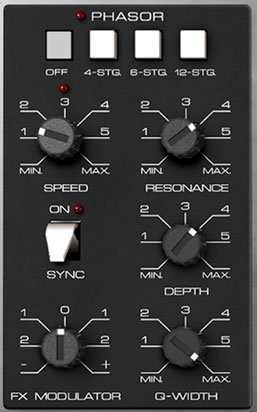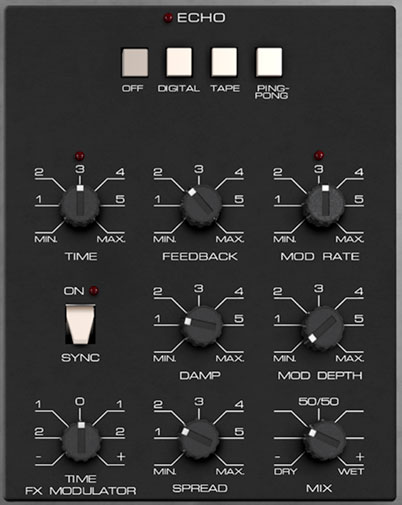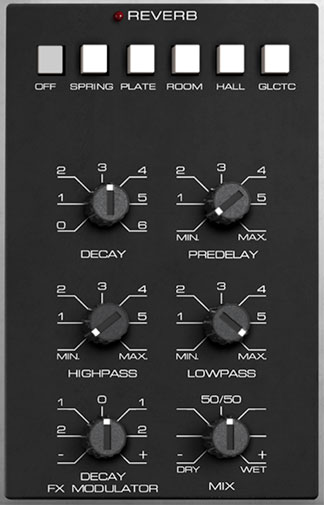
Atomika includes four simultaneous effects: Phasor, Flanger/Chorus, Echo, and Reverb. These can be used in any combination. In case you're wondering why we didn't include an overdrive or distortion effect, it's because Atomika's Filter and Amp sections have so many colorful flavors of distortion, we figured a dedicated effect would be superfluous (also, we were running out of panel space and thought the FX Mod section was more useful!).
Phasor

Mode buttons-
Off- Phasor effect is disabled.
4/6/12 Stage setting- Atomika's phasor includes up to 12 all-pass filter stages. As a general rule, more stages = lusher phase, but there are plenty of interesting tones to be had using the lower stage settings.
Speed- Sets the phasor's internal LFO speed from 0.01 to 8 Hz.
Resonance- Increasing the amount of Resonance intensifies the phasing effect. This is sometimes referred as "feedback" in other phasor units.
Sync- The Sync slide switch locks the rate of the Phasor's modulation LFO to the tempo in the top toolbar when using the Atomika standalone version, or to the current project tempo when the plug-in version is used in a DAW. When engaged, the Speed knob snaps to note values ranging from 1/64th note triplet to 8 beats.
Depth- Sets the effect depth - essentially an amount control.
FX Modulator- Sets the amount of sweep mod from the FX Modulator section in the top left corner. To disable the Phasor's dedicated LFO, set the Depth control to zero. This lets you use the FX Modulator only for mod. Alternatively, the Phasor's internal mod can be combined with the FX Modulator for unique modulation shapes (in this case, we recommend enabling sync and experimenting with Speed subdivision settings for both).
Q Width- Sets the nominal frequency spread size or "bandwidth" of the all-pass filters. This control noticeably alters the overall tone and character - be sure to try it when experimenting with stage and feedback settings.
Flange/Chorus

We've included a thick and warm flange/chorus effect. Flanging and Chorus are closely related - the general difference being that flangers use a shorter time range and some amount of feedback (this intensifies the "jet-flyby" whoosh), whereas choruses utilize a slightly longer delay time, and no feedback.
Mode buttons-
Off- Flange/Chorus effect is disabled.
Flange- Flange mode is enabled.
Chorus- Chorus mode is enabled. Note that the Resonance knob is disabled when in Chorus mode.
Speed- Sets the phaser's internal LFO speed from 0.01 to 8 Hz.
Res- Sets the amount of internal feedback when in Flange mode. Higher values result in a more intense flange sound.
Sync- The Sync slide switch locks the rate of the Flange/Chorus's modulation LFO to the tempo in the top toolbar when using the Atomika standalone version, or to the current project tempo when the plug-in version is used in a DAW. When engaged, the Speed knob snaps to note values ranging from 1/64th note triplet to 8 beats.
Depth- Sets effect depth, i.e. the amount of modulation.
FX Modulator- Sets the amount of sweep mod from the FX Modulator section in the top left corner. To disable the Flange/Chorus's dedicated LFO, set the Depth control to zero. This lets you use the FX Modulator only for mod. Alternatively, the Flange/Chorus's internal mod can be combined with the FX Modulator for unique modulation shapes (in this case, we recommend enabling sync and experimenting with Speed subdivision settings for both).
Mix- Sets the ratio of clean to effected sound. Flanging and chorusing is usually optimal at a 50/50 setting, but we've added the Mix control by popular demand to allow more subtle (or warble-riffic) tones.
Echo

Atomika's Echo includes digital, tape, and ping-pong, plus cool modulation section.
Mode buttons-
Off- Disables Echo effect.
Digital- A pristine sounding digital delay.
Tape- Reproduces the effect of a vintage "space echo" tape delay.
Ping Pong- Echoes alternate between audio channels.
Time- Sets delay time, from 1 to 2000 ms. If the Sync button is enabled, time settings snap to synchronized note values.
Feedback- Routes the output to the input for additional repeats. Be careful at high settings as this can result in runaway feedback madness.
Mod Rate- Sets the rate of delay time modulation from 0.20 to 20 Hz.
Sync- The Sync switch locks the delay time to master tempo. When engaged, the Time knob snaps to note values ranging from 1/64th note triplet to 8 beats. Sync mode locks to the tempo in the top toolbar when using the Atomika standalone version or the current project tempo when the plug-in version is used in a DAW.
Damp- Attenuates high-frequencies as the knob amount is increased. Not only does this create more natural sounding decays, it also reduces the "stacking" effect that occurs with high feedback levels.
Mod Depth- Sets the depth of delay modulation. Lower settings give delays a nice, subtle warble. Higher settings can result in the infamous Steve Stevens "raygun" effect. (If I was that guy, I'd change my middle name to Stefan, just to confuse people.)
Time FX Modulator- Sets the amount of sweep mod from the FX Modulator section in the top left corner. To disable the Echo's mod LFO, make sure the Mod Depth control is set to zero. This lets you use the FX Modulator only for mod. Or use both...
Spread- Alters the left and right channel delay times creating a stereoizing effect. Greater amounts of spread increase the delay time differential and thus the stereo separation.
Mix- Sets the ratio of clean to effected sound.
Reverb

Mode buttons-
Off- Disables Reverb effect.
Spring- Recreates mechanical spring-reverb effect often seen (and kicked) in vintage guitar amps.
Plate- A medium-to-large studio plate-style algorithm.
Room- Recreates a vintage algorithmic-style medium room verb.
Hall- A large, hall-style reverb.
Galactic- Cherry Audio's exclusive, giant, spacey reverb.
Decay- Sets the length of reverb release time/size of room.
Predelay- Sets the length of time until the onset of reverb from 0 to 150 ms.
HP- A highpass filter affecting wet reverb signal only. Low frequencies are increasingly attenuated as the knob setting is increased.
LP- A lowpass filter affecting wet reverb signal only High frequencies are increasingly attenuated as the knob setting is decreased.
Decay FX Modulator- Sets the amount of modulation of decay time from the FX Modulator section in the top left corner. To disable the Flange/Chorus's dedicated LFO, set the Depth control to zero. This lets you use the FX Modulator only for mod.
Mix- Sets the ratio of clean to effected sound.